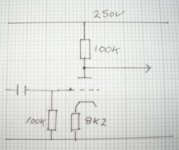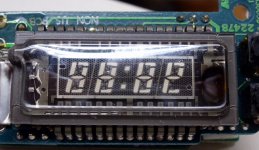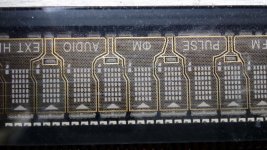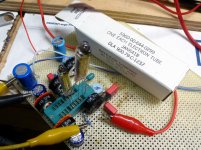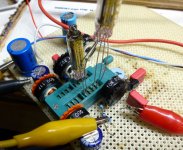Does anyone know,
Of a sub miniature (solder connection) tube that can be used in a HIFI low gain stage using the standard HT voltages similar to ECC82 etc?
Regards
M. Gregg
Of a sub miniature (solder connection) tube that can be used in a HIFI low gain stage using the standard HT voltages similar to ECC82 etc?
Regards
M. Gregg
I’m not sure I understand this aspect of your request, “using the standard HT voltages similar to ECC82” unless you are looking to wire a sub-mini to a 9-pin base to just plug in with no other changes to a 12AU7 socket.
Your best single reference for sub-mini tube spec’s is Frank’s data pages, or in hard copy, GE’s Essential Characteristics data book.
Without knowing exactly what you are looking for, twin triode or not, here are a few you might want to look at with Mu around 12AU7. Russian sub-minis will probably be your best bet, many like the 6N16B, 6N17B, 6N21B, will safely take 200V or more on the plate. Single triodes like 6S26B, 6S27B, 6S32B, work to 250V.
Non-Russian tubes are usually spec’ed around 150V but can be used higher safely. Twin triodes like the 6021, 6111, 6BF7, and single triodes like the 5977, and there are plenty more.
The lower plate spec can be an advantage, allow direct connection without negative rails or excessive B+.
Matt
Your best single reference for sub-mini tube spec’s is Frank’s data pages, or in hard copy, GE’s Essential Characteristics data book.
Without knowing exactly what you are looking for, twin triode or not, here are a few you might want to look at with Mu around 12AU7. Russian sub-minis will probably be your best bet, many like the 6N16B, 6N17B, 6N21B, will safely take 200V or more on the plate. Single triodes like 6S26B, 6S27B, 6S32B, work to 250V.
Non-Russian tubes are usually spec’ed around 150V but can be used higher safely. Twin triodes like the 6021, 6111, 6BF7, and single triodes like the 5977, and there are plenty more.
The lower plate spec can be an advantage, allow direct connection without negative rails or excessive B+.
Matt
Hi thank's for the reply,
I'm looking at putting a Sub miniature in a 12au7 circuit.
I know it sounds a bit strange..😀
I want to use a 12au7 x4 line stage circuit in a very small space.
( I don't want to use a FET)..but its another option.
Do you know which is the "Best" of these you quoted
6S26B, 6S27B, 6S32B I guess there isn't a double triode same kind of voltage..😀
B+ will be around 250-270V.
Regards
M. Gregg
I'm looking at putting a Sub miniature in a 12au7 circuit.
I know it sounds a bit strange..😀
I want to use a 12au7 x4 line stage circuit in a very small space.
( I don't want to use a FET)..but its another option.
Do you know which is the "Best" of these you quoted
6S26B, 6S27B, 6S32B I guess there isn't a double triode same kind of voltage..😀
B+ will be around 250-270V.
Regards
M. Gregg
Last edited:
Those tubes are very cheap so you better determine "best".
Since this is DIY and you want to create a physically small line stage why not just design circuit for the tube? Higher than necessary B+ makes any capacitor you use bigger than it needs to be. The volume of a 80V line stage can be much smaller than one designed for 270V, and the power supply is much smaller as well. If your power supply is non-negotiable you can always use a dropping resistor and decoupling cap to lower the plate voltage.
If you post the circuit with voltages you wish to use sub-mini tubes in that might help figure out what options work. Sub-mini's are small, two single triode tubes, especially of the flat bottle type, are not much larger than a twin triode in some cases.
Matt
Since this is DIY and you want to create a physically small line stage why not just design circuit for the tube? Higher than necessary B+ makes any capacitor you use bigger than it needs to be. The volume of a 80V line stage can be much smaller than one designed for 270V, and the power supply is much smaller as well. If your power supply is non-negotiable you can always use a dropping resistor and decoupling cap to lower the plate voltage.
If you post the circuit with voltages you wish to use sub-mini tubes in that might help figure out what options work. Sub-mini's are small, two single triode tubes, especially of the flat bottle type, are not much larger than a twin triode in some cases.
Matt
Thinking about something like this..
Perhaps a 5718..put another 100k in series with the supply and reduce the B+..140-150V??
However I'm not familiar with the micro phonics and the types. ie the "Best" one.. 😀
http://frank.pocnet.net/sheets/079/5/5718.pdf
Regards
M. Gregg
Perhaps a 5718..put another 100k in series with the supply and reduce the B+..140-150V??
However I'm not familiar with the micro phonics and the types. ie the "Best" one.. 😀
http://frank.pocnet.net/sheets/079/5/5718.pdf
Regards
M. Gregg
Attachments
Last edited:
6N16B Twin-triode, 200V plate max, Mu 25, Rp 5K ohms
6BF7W Twin triode, 110V plate max, Mu 35, Rp 7K ohms
6S31B Single-triode, 100V plate max, Mu 17, Rp 950 ohms
5977 Single-triode, 180V plate max, Mu 16, Rp
I assume you need that input cap because you have DC on your signal, but I do not understand the large unbiased cathode resister as well as the large plate load for a 12AU7 type. I trust you have heard 12AU7s in this circuit and like what you hear.
You should be able to plug a pair of 5977s into that circuit and get something that sounds as good as a 12AU7 in there. Remember a pair 5977s have half the filament requirement of a 12AU7 so you might want to adjust to suit.
One 6N16B will sub in as well but its filament demands are more than a 12AU7 so you will need to pay attention to that issue and see what your filament supply does.
If you want a line stage for audio I would think going with the data sheet suggestions for operating points would be a better place to start. For example, 6N16B, 100V on the plate, 325 ohm cathode resister, 6.5mA plate current, and a 30K plate resistor suggesting a B+ of 280V. For 5977, 100V plate voltage, 270 ohm cathode resister, 10mA plate current and a 20K plate resistor B+ of 300V needed. You would only need to change two resisters to adapt, given your 250V B+.
A smart tuned circuit topology impacts sound more than any special tube. Good luck.
Matt
6BF7W Twin triode, 110V plate max, Mu 35, Rp 7K ohms
6S31B Single-triode, 100V plate max, Mu 17, Rp 950 ohms
5977 Single-triode, 180V plate max, Mu 16, Rp
I assume you need that input cap because you have DC on your signal, but I do not understand the large unbiased cathode resister as well as the large plate load for a 12AU7 type. I trust you have heard 12AU7s in this circuit and like what you hear.
You should be able to plug a pair of 5977s into that circuit and get something that sounds as good as a 12AU7 in there. Remember a pair 5977s have half the filament requirement of a 12AU7 so you might want to adjust to suit.
One 6N16B will sub in as well but its filament demands are more than a 12AU7 so you will need to pay attention to that issue and see what your filament supply does.
If you want a line stage for audio I would think going with the data sheet suggestions for operating points would be a better place to start. For example, 6N16B, 100V on the plate, 325 ohm cathode resister, 6.5mA plate current, and a 30K plate resistor suggesting a B+ of 280V. For 5977, 100V plate voltage, 270 ohm cathode resister, 10mA plate current and a 20K plate resistor B+ of 300V needed. You would only need to change two resisters to adapt, given your 250V B+.
A smart tuned circuit topology impacts sound more than any special tube. Good luck.
Matt
I just saw these,
10pc SUBMINIATURE8 B8D Tube Adapter Bare PCB for GE6021 6N16B 6N21B 2 0mm | eBay
They might be of use as you experiment. I also have wired sub-minis to 9-pin socket savers like this, I just solder them right to the socket.
10x 9pin Tube Socket Saver Fr 12AX7 12AU7 ECC82 ECC83 TS 9 | eBay
but this is only an advantage if you have a 9-pin socket that you want to try different sub-mini's in. If you solder in circuit your needs are different.
Matt
10pc SUBMINIATURE8 B8D Tube Adapter Bare PCB for GE6021 6N16B 6N21B 2 0mm | eBay
They might be of use as you experiment. I also have wired sub-minis to 9-pin socket savers like this, I just solder them right to the socket.
10x 9pin Tube Socket Saver Fr 12AX7 12AU7 ECC82 ECC83 TS 9 | eBay
but this is only an advantage if you have a 9-pin socket that you want to try different sub-mini's in. If you solder in circuit your needs are different.
Matt
The 6111 is similar to the 12AU7 and can often be used in the same circuit with some resistor value tweaks. You must keep the dissipation down by reducing plate voltage, plate current or both. I have used the 6111 and the 6021 (higher gain) in a guitar preamp that fits inside the guitar. I run a B+ of 250 volts with about 125 volts on the plate. Current is about 5 mA if I remember right. These tubes will fit into a round 8 pin IC socket with a little pin bending and careful insertion...there is no keyway on the IC socket. They can be used in a machined pin 8 pin DIP IC socket with a lot of pin bending.
I've played with 6021, 6111, 6BF7's in a portable headphone amp running a whopping 12v and they sounded surprisingly good. Always wanted to try them with a proper voltage so watching this thread with interest..
For testing i plugged them into an 8pin dip socket as above, they dont make it easy to identify the pins so after you have squinted at them a few times trying to figure it out you will see the value of that approach.
For testing i plugged them into an 8pin dip socket as above, they dont make it easy to identify the pins so after you have squinted at them a few times trying to figure it out you will see the value of that approach.
I built a bunch of line preamps many years ago using 6111WA, they are v similar to an ECC82 / 12AU7 in a pencil envelope, except they sound better !
Microphony was v low, only issue with noise is that some of them could start to hiss quite a bit after a few hours use, but if they were quiet after about 10 hours, they stayed quiet.
I used small round 8 pin IC sockets for mounting, or you could just solder them in place as Audio Note UK did in the M Zero preamp.
Microphony was v low, only issue with noise is that some of them could start to hiss quite a bit after a few hours use, but if they were quiet after about 10 hours, they stayed quiet.
I used small round 8 pin IC sockets for mounting, or you could just solder them in place as Audio Note UK did in the M Zero preamp.
they dont make it easy to identify the pins so after you have squinted at them a few times
The tubes have a missing pin like the 7 and 9 pin miniatures. Some of the sockets have a pin 1 bump, some don't. I just mark the socket and the tube with a Sharpie once you get it right.
6s31b tube sound experiment
I actually wondered how is sounding the 6s31b subminiature tube. I have built a buffer circuit and tested 6s31b tubes in cathode follower mode with bipolar psu. Sounded dark (close) to me when comparing with 6n30p-dr. I just wanted to share my experiment.
I actually wondered how is sounding the 6s31b subminiature tube. I have built a buffer circuit and tested 6s31b tubes in cathode follower mode with bipolar psu. Sounded dark (close) to me when comparing with 6n30p-dr. I just wanted to share my experiment.
Last edited:
How about the 6N16?
http://www.mif.pg.gda.pl/homepages/frank/sheets/113/6/6N16B.pdf
Cheap, plentiful and good curves. 100V 6mA -2V looks very good.
http://www.mif.pg.gda.pl/homepages/frank/sheets/113/6/6N16B.pdf
Cheap, plentiful and good curves. 100V 6mA -2V looks very good.
As it happens ....
I just had occasion to do precisely that.
I wanted to use the miniature tubes for a guitar overdrive pedal. Initially, I just got it working using standard 9-pin tubes (12AU7 & EF86), since they are known quantities. In order to test the circuit with the corresponding mini tubes (6111 & CK5840), I used a pair of these:
https://www.tubedepot.com/products/9-pin-socket-saver
Just wired the leads from the mini to the corresponding pins in the adapter (a bit tricky, but do-able).
Works like a charm.
(The result is a bit taller than a standard 12A*7 alone, so check your headroom first.)
I just had occasion to do precisely that.
I wanted to use the miniature tubes for a guitar overdrive pedal. Initially, I just got it working using standard 9-pin tubes (12AU7 & EF86), since they are known quantities. In order to test the circuit with the corresponding mini tubes (6111 & CK5840), I used a pair of these:
https://www.tubedepot.com/products/9-pin-socket-saver
Just wired the leads from the mini to the corresponding pins in the adapter (a bit tricky, but do-able).
Works like a charm.
(The result is a bit taller than a standard 12A*7 alone, so check your headroom first.)
I am working on two projects. One is a preamp for use inside a guitar. The other is a vacuum tube VCF for a music synthesizer. The guitar is a ways off time wise, and the synth module is a current project, but I wanted to find a basic gain stage design that will work for both, and some other synth modules that are possible. First off I needed to choose a good tube.
The plan is for a separate preamp for each string driven by piezoelectric string saddles in the Tele bridge. There will be yet another pickup for each of the two conventional magnetic pickups. Audio mixing, and MIDI (one channel per string) will also be done inside the guitar. All electronics must operate from a replaceable rechargeable battery, with 8 hours or so of battery life. This will probably be a 7.2 volt battery intended for an RC car. They are available in Lithium or NiMH. 8 tubes minimum, plus some solid state analog and digital electronics inside the guitar immediately identifies the two prime goals of circuit design, small size and low power consumption. Reasonable distortion, the ability to vary the gain, and a reasonable output level are secondary goals.
The other project involves some music synthesizer modules using vacuum tube tech. There are two popular formats here, with Eurorack being the smallest, with the lowest power consumption. Heat buildup is an issue since the modules must coexist with some other analog synth modules designed in the late 60's, but still quite popular, that are particularly temperature sensitive (Moog and ARP VCO clones). Again, size, power consumption, and now output voltage (10 volts P-P is a standard) are the prime goals. Reasonable distortion and gain variability are secondary.
The first thing that comes to mind is the Korg Nutube, an offshoot of VFD display technology, Nutubes are small, low powered, and cool looking. The big drawback is cost. At $50 each in small quantities, 8 of these blows my entire project budget. I tested two used VFD's that I have, but they didn't work too well. The HP display turned out to be bad (gone to air) and two (out of two) of the clock displays could not be brought below 10% distortion.
I decided to explore subminiature tubes, since I have a box full of them. Subminiature tubes come in two flavors:
Conventional indirectly heated triodes or pentodes that have been reduced in size, but don't save much power. The previously mentioned 6111, 6112 and 5840 are examples of these. Most have 8 pins or wires in a circle. They can be made to fit in the old 8 pin round IC sockets, or with some bending, an 8 pin DIP socket. Unfortunately each requires 6.3 volts at 150 mA or more for each heater. Roughly 1 watt minimum to light the heaters alone will not work in my applications, too bad, I have hundreds of several types.
Directly heated tubes intended for hearing aids or other miniature low power applications. Some run on very little power due to a tiny heater made of very thin tungsten wire, but are often microphonic because the thin wire will vibrate. Some can run on very low power. Most have 4, 5 or 6 pins or wires in a row on .050 inch centers. They will fit in a 0.10 inch machined pin strip socket, or two can go into a dip socket side by side.
I made a test board to develop a gain stage that I will need for the projects that I am working on. I used a Textool ZIF socket originally used for programming 18 pin PIC chips. I used it to allow for testing a lot of tubes. I ran about 20 6418 tubes through the circuit several times, swapping them live without even turning off the power. I didn't blow any parts doing this. Some other tubes are on order to find the best compromise between gain, distortion, and power consumption. I made this breadboard such that EVERYTHING is adjustable, hence the collection of pots. I tweaked it for several possible operating conditions, then ran several tubes through it, finally choosing a good set for the 6418's. I will repeat for a few different tube choices after I get several of each kind.
The little breadboard that I built consumes 35 milliwatts for each gain stage (1 tube and 1 mosfet) total (heater and B+), with a 6418 tube. About 10 milliwatts is wasted in a simple filament bias scheme. This can be reclaimed if needed at the expense of circuit complexity. Total stage gain is variable from below unity to about 40 by adjusting the load impedance. Distortion can be optimized to a very low number. I saw less than 0.2% on one tube at 10 volts P-P output on a 60 volt supply with 30 volts on the plate at 400 uA. However tube to tube variation is huge, but I found a setting that allowed less than 1% on all tubes at 10 V P-P output.
The plan is for a separate preamp for each string driven by piezoelectric string saddles in the Tele bridge. There will be yet another pickup for each of the two conventional magnetic pickups. Audio mixing, and MIDI (one channel per string) will also be done inside the guitar. All electronics must operate from a replaceable rechargeable battery, with 8 hours or so of battery life. This will probably be a 7.2 volt battery intended for an RC car. They are available in Lithium or NiMH. 8 tubes minimum, plus some solid state analog and digital electronics inside the guitar immediately identifies the two prime goals of circuit design, small size and low power consumption. Reasonable distortion, the ability to vary the gain, and a reasonable output level are secondary goals.
The other project involves some music synthesizer modules using vacuum tube tech. There are two popular formats here, with Eurorack being the smallest, with the lowest power consumption. Heat buildup is an issue since the modules must coexist with some other analog synth modules designed in the late 60's, but still quite popular, that are particularly temperature sensitive (Moog and ARP VCO clones). Again, size, power consumption, and now output voltage (10 volts P-P is a standard) are the prime goals. Reasonable distortion and gain variability are secondary.
The first thing that comes to mind is the Korg Nutube, an offshoot of VFD display technology, Nutubes are small, low powered, and cool looking. The big drawback is cost. At $50 each in small quantities, 8 of these blows my entire project budget. I tested two used VFD's that I have, but they didn't work too well. The HP display turned out to be bad (gone to air) and two (out of two) of the clock displays could not be brought below 10% distortion.
I decided to explore subminiature tubes, since I have a box full of them. Subminiature tubes come in two flavors:
Conventional indirectly heated triodes or pentodes that have been reduced in size, but don't save much power. The previously mentioned 6111, 6112 and 5840 are examples of these. Most have 8 pins or wires in a circle. They can be made to fit in the old 8 pin round IC sockets, or with some bending, an 8 pin DIP socket. Unfortunately each requires 6.3 volts at 150 mA or more for each heater. Roughly 1 watt minimum to light the heaters alone will not work in my applications, too bad, I have hundreds of several types.
Directly heated tubes intended for hearing aids or other miniature low power applications. Some run on very little power due to a tiny heater made of very thin tungsten wire, but are often microphonic because the thin wire will vibrate. Some can run on very low power. Most have 4, 5 or 6 pins or wires in a row on .050 inch centers. They will fit in a 0.10 inch machined pin strip socket, or two can go into a dip socket side by side.
I made a test board to develop a gain stage that I will need for the projects that I am working on. I used a Textool ZIF socket originally used for programming 18 pin PIC chips. I used it to allow for testing a lot of tubes. I ran about 20 6418 tubes through the circuit several times, swapping them live without even turning off the power. I didn't blow any parts doing this. Some other tubes are on order to find the best compromise between gain, distortion, and power consumption. I made this breadboard such that EVERYTHING is adjustable, hence the collection of pots. I tweaked it for several possible operating conditions, then ran several tubes through it, finally choosing a good set for the 6418's. I will repeat for a few different tube choices after I get several of each kind.
The little breadboard that I built consumes 35 milliwatts for each gain stage (1 tube and 1 mosfet) total (heater and B+), with a 6418 tube. About 10 milliwatts is wasted in a simple filament bias scheme. This can be reclaimed if needed at the expense of circuit complexity. Total stage gain is variable from below unity to about 40 by adjusting the load impedance. Distortion can be optimized to a very low number. I saw less than 0.2% on one tube at 10 volts P-P output on a 60 volt supply with 30 volts on the plate at 400 uA. However tube to tube variation is huge, but I found a setting that allowed less than 1% on all tubes at 10 V P-P output.
Attachments
- Home
- Amplifiers
- Tubes / Valves
- Sub minature tube gain stage question.
